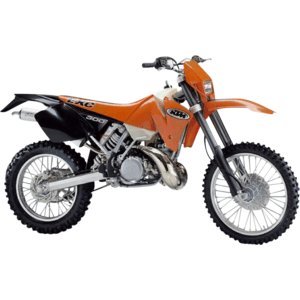KTM 300 EXC (1996–2003): The Two-Stroke Enduro Legend Revisited
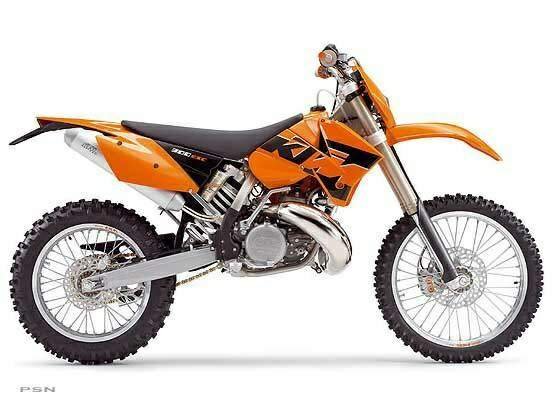
Introduction
The KTM 300 EXC isn’t just a motorcycle—it’s a rite of passage for enduro enthusiasts. Produced from 1996 to 2003, this Austrian icon redefined what riders expected from a two-stroke off-road machine. With its snarling 297cc engine, race-bred suspension, and featherweight agility, the 300 EXC became a benchmark for hardcore trail riders and weekend warriors alike. After spending time aboard a well-preserved 2001 model, it’s clear why this bike still commands cult-like admiration. Let’s dive into what makes this orange beast tick—and why it remains relevant even in today’s four-stroke-dominated world.
Engine Performance: Two-Stroke Thunder, Refined
At the heart of the KTM 300 EXC lies its 297cc liquid-cooled single-cylinder two-stroke engine. This isn’t your uncle’s smoke-belching dirt bike; it’s a precision instrument. The powerband is a masterclass in versatility:
- Low-end torque that chugs up hills like a tractor (thanks to a 72mm bore and 73mm stroke in early models).
- A violent mid-range punch that launches you out of corners.
- A surprisingly usable top-end for a two-stroke, though it signs off earlier than pure MX bikes.
The Keihin PWK carburetor (ranging from 36mm to 38mm across generations) delivers crisp throttle response. Cold starts require patience—2-3 kicks when temperatures drop—but once warm, the engine barks to life eagerly. KTM’s Kokusan digital ignition (post-2000 models) eliminated the finicky SEM system, improving reliability.
Key Numbers:
- 23 hp @ 6,120 rpm (17 kW) – enough to humble modern 450s in tight woods
- Fuel mix: 60:1 with synthetic oil (though old-school riders still swear by 50:1)
- Fuel capacity: 8.5–13L (2.2–3.4 US gal), depending on year
Riding the 300 EXC feels like taming a wild animal. On loamy Pacific Northwest trails, the engine hooks up beautifully, but Arizona-hardpack demands finesse—whisper-thin throttle control to avoid spinning the Michelin MP11 rear tire into oblivion.
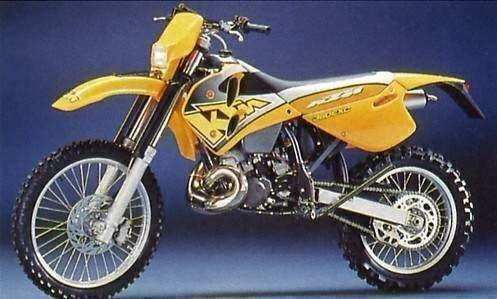
Handling & Suspension: Agile Meets Unbreakable
KTM’s chromoly steel frame (CrMo4 in later models) strikes a perfect balance between flex and rigidity. At 109 kg (240 lbs) dry, the 300 EXC flicks through switchbacks like a trials bike. The 62.5° head angle and 1,481mm wheelbase (58.3") inspire confidence at speed without sacrificing low-speed maneuverability.
Suspension Evolution:
- 1996–1998: Marzocchi 45mm forks + Öhlins shock (stiff initially, but indestructible)
- 1999–2003: WP 48mm USD forks + WP PDS rear shock (plush, progressive, and endlessly adjustable)
With 295mm (11.6") of front travel and 320mm (12.6") out back, the 300 EXC soaks up everything from baby-head rocks to MX track landings. Test riders in the late ’90s complained about slow steering until they learned to trust the chassis—raise the forks 5mm in the triple clamps, and the bike transforms into a cornering razor.
Brakes & Wheels: Stopping Power, With Caveats
The Brembo single-disc brakes (260mm front/220mm rear) offer strong initial bite, but:
- Front brake: 2-piston caliper (post-2000) resists fade during long descents
- Rear brake: 1-piston caliper prone to hydroplaning through water crossings
Swap the stock organic pads for sintered metal ones immediately—they’ll survive more than 120 miles of abuse. The 21"/18" wheel combo wrapped in period-correct Michelins works… if you’re nostalgic for sliding. Most owners upgrade to modern rubber like Dunlop Geomax or Pirelli Scorpions.
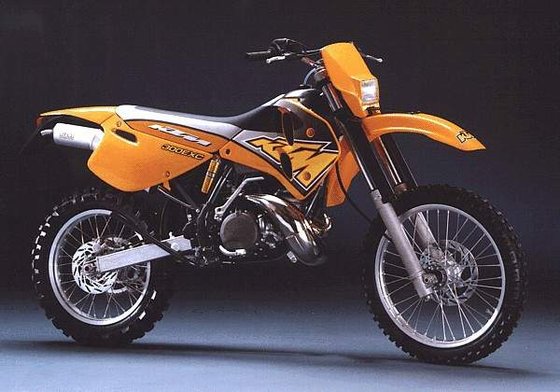
Competition: How the 300 EXC Stacks Up
In the late ’90s enduro scene, the KTM faced fierce rivals:
| Model | Weight | Engine | Suspension | Weakness |
|-------------------|--------------|--------------|---------------------|------------------------|
| KTM 300 EXC | 109 kg (240 lbs) | 297cc 2T | WP PDS | Tire choice (stock) |
| Yamaha WR250 | 116 kg (256 lbs) | 249cc 2T | KYB Speed Sensitive | Heavier, less torque |
| Honda CR250R | 105 kg (231 lbs) | 249cc 2T | Showa Twin-Chamber | MX-focused, stiff for trails |
| Husqvarna WR300 | 111 kg (245 lbs) | 293cc 2T | Marzocchi/Sachs | Erratic parts supply |
The KTM’s trump card? Versatility. It could podium in a GNCC race on Sunday and tackle technical single-track on Monday—all while being easier to rebuild than its Japanese counterparts.
Maintenance: Keeping the Legend Alive
Own a 300 EXC? Here’s your survival kit:
-
Air Filter
Clean every 10 hours. Use no-toil oil and seal the airbox with grease—these bikes are dust magnets. -
Cooling System
Replace coolant annually. The 1.3L system runs hot in slow terrain; consider a high-pressure radiator cap. -
Power Valve
Service every 50 hours. Carbon buildup here robs power and causes erratic RPMs. -
Chain & Sprockets
Stock Regina chains stretch faster than yoga instructors. Upgrade to a DID ERT2 and steel sprockets. -
Brake Fluid
Flush with DOT 4 yearly. The rear master cylinder loves to ingest mud.
Pro Tip: The stock NGK BR8ECM spark plug fouls easily in technical riding. Drop to a BR7ES for cleaner low-RPM operation.
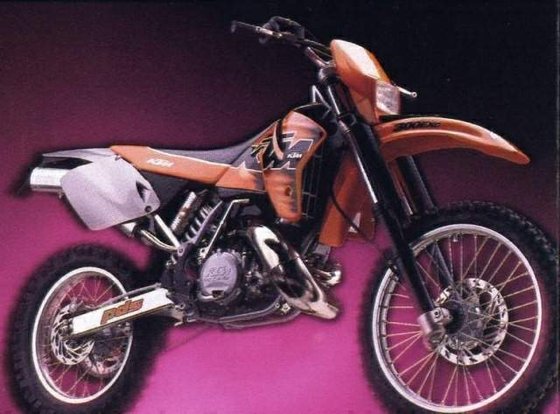
Conclusion: Why the 300 EXC Still Matters
Twenty years later, the KTM 300 EXC (1996–2003) remains a masterclass in two-stroke engineering. It’s raw yet refined, punishing yet forgiving—a bike that rewards skill and punishes complacency. While modern fuel-injected four-strokes dominate showrooms, this orange relic reminds us that lightweight simplicity never goes out of style.
Ready to resurrect your 300 EXC? MOTOPARTS.store carries everything from WP piston kits to period-correct graphics. Because legends deserve to live forever.
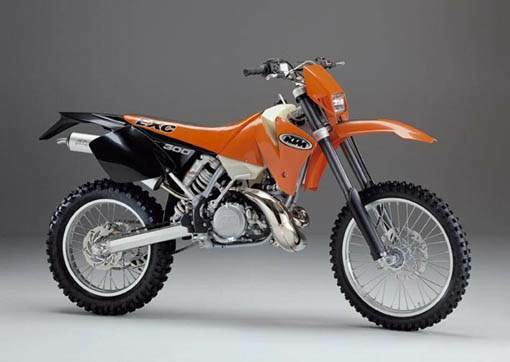


Specifications sheet
| Engine | |
|---|---|
| Stroke: | Two-stroke |
| Ignition: | SEM K11 CDI (1996-2000) / Kokusan digital 2K-3 (2001-2003) |
| Max power: | 17 kW | 23.0 hp |
| Fuel system: | Keihin PWK carburetor (varies: PWK38/PWK36) |
| Max power @: | 6120 rpm |
| Displacement: | 297 ccm |
| Configuration: | Single |
| Cooling system: | Liquid |
| Compression ratio: | 11.0:1 |
| Number of cylinders: | 1 |
| Dimensions | |
|---|---|
| Wheelbase: | 1480 mm (58.3 in) |
| Dry weight: | 108 |
| Seat height: | 945 mm (37.2 in) |
| Ground clearance: | 385 mm (15.2 in) |
| Fuel tank capacity: | 13 L (3.4 US gal) (1996-2000) / 8.5 L (2.2 US gal) (2001-2003) |
| Drivetrain | |
|---|---|
| Final drive: | chain |
| Chain length: | 118 |
| Transmission: | 5-speed |
| Rear sprocket: | 50 |
| Front sprocket: | 14 |
| Maintenance | |
|---|---|
| Rear tire: | 140/80-18 |
| Front tire: | 90/90-21 |
| Brake fluid: | DOT 4 |
| Gearbox oil: | SAE 30 |
| Spark plugs: | NGK BR8ECM or BR8ECMIX |
| Spark plug gap: | 0.6 |
| Coolant capacity: | 1.3 |
| Forks oil capacity: | 1.5 |
| Gearbox oil capacity: | 0.8 |
| Recommended tire pressure (rear): | 1.0 bar (14.5 psi) |
| Recommended tire pressure (front): | 1.0 bar (14.5 psi) |
| Additional Notes | |
|---|---|
| Premix ratio: | Varies by model year (refer to manual) |
| Weight variations: | Dry weight ranges 103-112 kg due to year-specific components |
| Suspension adjustments: | WP components standard from 1999 onward |
| Chassis and Suspension | |
|---|---|
| Frame: | Steel or chromium molybdenum twin cradle (varies by year) |
| Rear brakes: | Single 220 mm disc, 1-piston caliper |
| Front brakes: | Single 260 mm disc, 2-piston caliper |
| Rear suspension: | Öhlins 3A (1996-1998) / WP-PDS monoshock (1999-2003) |
| Front suspension: | Marzocchi 45 mm (1996-1998) / WP 48 mm USD (1999-2003) |
| Rear wheel travel: | 320 mm (12.6 in) |
| Front wheel travel: | 295 mm (11.6 in) |



